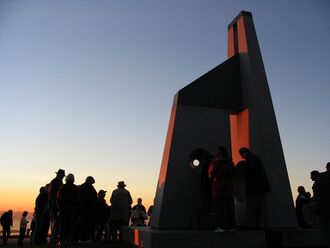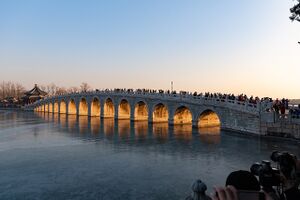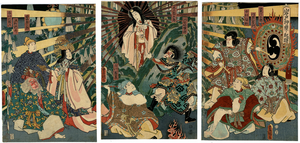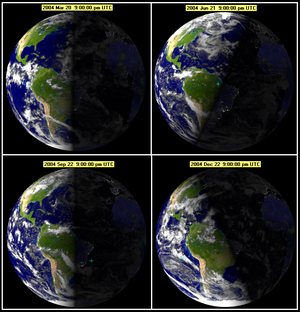| event | equinox | solstice | equinox | solstice | ||||
|---|---|---|---|---|---|---|---|---|
| month | March[3] | June[4] | September[5] | December[6] | ||||
| year | day | time | day | time | day | time | day | time |
| 2020 | 20 | 03:50 | 20 | 21:43 | 22 | 13:31 | 21 | 10:03 |
| 2021 | 20 | 09:37 | 21 | 03:32 | 22 | 19:21 | 21 | 15:59 |
| 2022 | 20 | 15:33 | 21 | 09:14 | 23 | 01:04 | 21 | 21:48 |
| 2023 | 20 | 21:25 | 21 | 14:58 | 23 | 06:50 | 22 | 03:28 |
| 2024 | 20 | 03:07 | 20 | 20:51 | 22 | 12:44 | 21 | 09:20 |
| 2025 | 20 | 09:02 | 21 | 02:42 | 22 | 18:20 | 21 | 15:03 |
| 2026 | 20 | 14:46 | 21 | 08:25 | 23 | 00:06 | 21 | 20:50 |
| 2027 | 20 | 20:25 | 21 | 14:11 | 23 | 06:02 | 22 | 02:43 |
| 2028 | 20 | 02:17 | 20 | 20:02 | 22 | 11:45 | 21 | 08:20 |
| 2029 | 20 | 08:01 | 21 | 01:48 | 22 | 17:37 | 21 | 14:14 |
| 2030 | 20 | 13:51 | 21 | 07:31 | 22 | 23:27 | 21 | 20:09 |
| Winter solstice | |
|---|---|
 At the Lawrence Hall of Science in California, visitors observe sunset on the day of the winter solstice using the Sunstones II. | |
| Also called | Midwinter; the Shortest Day; the Longest Night |
| Observed by | Various cultures |
| Type | Cultural, astronomical |
| Significance | Astronomically marks the beginning of lengthening days and shortening nights |
| Celebrations | Festivals, spending time with loved ones, feasting, singing, dancing, fires |
| Date | about December 21 (NH) about June 21 (SH) |
| Frequency | Twice a year (once in the northern hemisphere, once in the southern hemisphere, six months apart) |
| Related to | Winter festivals |
The winter solstice, also called the hibernal solstice, occurs when either of Earth's poles reaches its maximum tilt away from the Sun. This happens twice yearly, once in each hemisphere (Northern and Southern). For that hemisphere, the winter solstice is the day with the shortest period of daylight and longest night of the year, and when the Sun is at its lowest daily maximum elevation in the sky.[7] Each polar region experiences continuous darkness or twilight around its winter solstice.
The winter solstice occurs during the hemisphere's winter. In the Northern Hemisphere, this is the December solstice (usually 21 or 22 December) and in the Southern Hemisphere, this is the June solstice (usually 20 or 21 of June). Although the winter solstice itself lasts only a moment, the term also refers to the day on which it occurs. The term midwinter is also used synonymously with the winter solstice, although it carries other meanings as well. Traditionally, in many temperate regions, the winter solstice is seen as the middle of winter; although today in some countries and calendars it is seen as the beginning of winter. Other names are the "extreme of winter" (Dongzhi), or the "shortest day".
Since prehistory, the winter solstice has been a significant time of year in many cultures and has been marked by festivals and rituals.[8] It marked the symbolic death and rebirth of the Sun; the gradual waning of daylight hours is reversed and begins to grow again. Some ancient monuments such as Newgrange, Stonehenge, and Cahokia Woodhenge are aligned with the sunrise or sunset on the winter solstice.
History and cultural significance
There is evidence that the winter solstice was deemed an important moment of the annual cycle for some cultures as far back as the Neolithic (New Stone Age). Astronomical events were often used to guide farming activities, such as the mating of animals, the sowing of crops and the monitoring of winter reserves of food. The winter solstice was important because the people were economically dependent on monitoring the progress of the seasons. Starvation was common during the first months of the winter, January to April (northern hemisphere) or July to October (southern hemisphere). Livestock were slaughtered so they would not have to be fed during the winter, so it was almost the only time of year when a plentiful supply of fresh meat was available.[9]
Because the winter solstice is the reversal of the Sun's apparent ebbing in the sky, in ancient times it was seen as the symbolic death and rebirth of the Sun or of a Sun god.[10][11][12] In cultures which used cyclic calendars based on the winter solstice, the "year as reborn" was celebrated with reference to life-death-rebirth deities or "new beginnings" (such as Hogmanay's redding, a New Year cleaning tradition), and "reversal" (as in Saturnalia's slave and master reversals).[citation needed]
Neolithic Europe
Some important Neolithic and early Bronze Age archaeological sites in Europe are associated with the winter solstice, such as Stonehenge in England and Newgrange in Ireland. The primary axes of both of these monuments seem to have been carefully aligned on a sight-line pointing to the winter solstice sunrise (Newgrange) and the winter solstice sunset (Stonehenge). It is significant that at Stonehenge the Great Trilithon was oriented outwards from the middle of the monument, i.e. its smooth flat face was turned towards the midwinter Sun.[13]
Ancient Roman
In the ancient Roman calendar, December 25 was the date of the winter solstice.[14][15] In AD 274, the emperor Aurelian made this the date of the festival Dies Natalis Solis Invicti, the birthday of Sol Invictus or the 'Invincible Sun'.[15][16] Gary Forsythe, Professor of Ancient History, says "This celebration would have formed a welcome addition to the seven-day period of the Saturnalia (December 17–23), Rome's most joyous holiday season since Republican times, characterized by parties, banquets, and exchanges of gifts".[15]
A widely-held theory is that the Church chose December 25 as Christ's birthday (Dies Natalis Christi) to appropriate the Roman winter solstice festival marking the sun god's birthday (Dies Natalis Solis Invicti).[16][15][17]
Germanic
In Anglo-Saxon England the winter solstice was generally deemed to be 25 December, and in Old English, midwinter could mean both the winter solstice and Christmas.[18][19]
The North Germanic peoples celebrated a winter holiday called Yule. The Heimskringla, written in the 13th century by the Icelander Snorri Sturluson, describes a Yule feast hosted by the Norwegian king Haakon the Good (c. 920–961). According to Snorri, the Christian Haakon had moved Yule from "midwinter" and aligned it with the Christian Christmas celebration. Historically, this has made some scholars believe that Yule originally was a sun festival on the winter solstice. Modern scholars generally do not believe this, as midwinter in medieval Iceland was a date about four weeks after the solstice.[20] During the Christianisation of the Germanic peoples, Yule was incorporated into the Christmas celebrations and the term and its cognates remain used to refer to Christmas in modern Northern European languages such as English and Swedish.[21][22]
East Asian

In East Asia, the winter solstice has been celebrated as one of the Twenty-four Solar Terms, called Dongzhi (冬至) in Chinese. In Japan, in order not to catch cold in the winter, there is a custom to soak oneself in a yuzu hot bath (Japanese: 柚子湯 = Yuzuyu).[23]
Indian
Makara Sankranti, also known as Makara Sankrānti (Sanskrit: मकर संक्रांति) or Maghi, is a festival day in the Hindu calendar, in reference to deity Surya (sun). It is observed each year in January.[24] It marks the first day of Sun's transit into Makara (Capricorn), marking the end of the month with the winter solstice and the start of longer days.[24][25]
Iranian
Iranian people celebrate the night of the Northern Hemisphere's winter solstice as, "Yalda night", which is known to be the "longest and darkest night of the year". Yalda night celebration, or as some call it "Shabe Chelleh" ("the 40th night"), is one of the oldest Iranian traditions that has been present in Persian culture from ancient times. In this night all the family gather together, usually at the house of the eldest, and celebrate it by eating, drinking and reciting poetry (esp. Hafez). Nuts, pomegranates and watermelons are particularly served during this festival.
Judaic
An Aggadic legend found in tractate Avodah Zarah 8a puts forth the talmudic hypothesis that Adam first established the tradition of fasting before the winter solstice, and rejoicing afterward, which festival later developed into the Roman Saturnalia and Kalendae.
When the First Man saw that the day was continuously shortening, he said, "Woe is me! Because I have sinned, the world darkens around me, and returns to formlessless and void. This is the death to which Heaven has sentenced me!" He decided to spend eight days in fasting and prayer. When he saw the winter solstice, and he saw that the day was continuously lengthening, he said, "It is the order of the world!" He went and feasted for eight days. The following year, he feasted for both. He established them in Heaven's name, but they established them in the name of idolatry[26]
Observation
Although the instant of the solstice can be calculated,[27] direct observation of the moment by visual perception is elusive. The Sun moves too slowly or appears to stand still (the meaning of "solstice"). However, by use of astronomical data tracking, the precise timing of its occurrence is now public knowledge. The precise instant of the solstice cannot be directly detected (by definition, people cannot observe that an object has stopped moving until it is later observed that it has not moved further from the preceding spot, or that it has moved in the opposite direction). To be precise to a single day, observers must be able to view a change in azimuth or elevation less than or equal to about 1/60 of the angular diameter of the Sun. Observing that it occurred within a two-day period is easier, requiring an observation precision of only about 1/16 of the angular diameter of the Sun. Thus, many observations are of the day of the solstice rather than the instant. This is often done by observing sunrise and sunset or using an astronomically aligned instrument that allows a ray of light to be cast on a certain point around that time. The earliest sunset and latest sunrise dates differ from winter solstice, however, and these depend on latitude, due to the variation in the solar day throughout the year caused by the Earth's elliptical orbit (see earliest and latest sunrise and sunset).
- 2013 Solstice Newgrange.jpg
Sunlight entering the passage of Newgrange in Ireland on the winter solstice
- Goseck-2.jpg
Neolithic site of Goseck circle in Germany. The yellow lines indicate the directions in which sunrise and sunset are seen on the day of the winter solstice.
- StonehengeSunrise1980s.jpg
Sunrise at Stonehenge in southern England on the winter solstice
Holidays celebrated on the winter solstice
- Alban Arthan (Welsh)
- Blue Christmas (holiday) (Western Christian)
- Brumalia (Ancient Rome)
- Dongzhi Festival (East Asia)
- Inti Raymi (Inca)
- Koliada and Korochun (Slavic)
- Midwinter Day (Antarctica)
- Sanghamitta Day (Theravada Buddhism)
- Shabe Yalda (Iran)
- Shalako (Zuni)
- We Tripantu (Mapuche)
- Willkakuti (Aymara)
- Yaldā (Western and Central Asia)
- Yule in the Northern Hemisphere (Germanic)
- Ziemassvētki (ancient Latvia)
- Cejna Êzî/Êzîd (Yazidi): Feast of Êzîd – Celebrated on the last Friday before winter solstice
- Saturnalia (Ancient Rome): Celebrated shortly before winter solstice
- Saint Lucy's Day (Christian): Used to coincide with the winter solstice day, now celebrated on December 13
- Cold Food Festival (Korea, Greater China): 105 days after winter solstice
- Makar Sankranti (India): Harvest Festival – Marks the end of the cold months and start of the new month with longer days.
- Winter at Tantora Festival (Saudi Arabia): Cultural festival marking the beginning of the winter harvest season.
See also
References
- ↑ Lua error in Module:Citation/CS1/Configuration at line 2123: attempt to index field '?' (a nil value).
- ↑ Lua error in Module:Citation/CS1/Configuration at line 2123: attempt to index field '?' (a nil value).
- ↑ Équinoxe de printemps entre 1583 et 2999
- ↑ Solstice d’été de 1583 à 2999
- ↑ Équinoxe d’automne de 1583 à 2999
- ↑ Solstice d’hiver
- ↑ Lua error in Module:Citation/CS1/Configuration at line 2123: attempt to index field '?' (a nil value).
- ↑ Lua error in Module:Citation/CS1/Configuration at line 2123: attempt to index field '?' (a nil value).
- ↑ Lua error in Module:Citation/CS1/Configuration at line 2123: attempt to index field '?' (a nil value).
- ↑ Krupp, E C. Echoes of the Ancient Skies: The Astronomy of Lost Civilizations. Courier Corporation, 2012. pp. 119, 125, 195
- ↑ North, John. Stonehenge. The Free Press, 1996. p. 530
- ↑ Hadingham, Evan. Early Man and the Cosmos. University of Oklahoma Press, 1985. p. 50
- ↑ Lua error in Module:Citation/CS1/Configuration at line 2123: attempt to index field '?' (a nil value).
- ↑ Lua error in Module:Citation/CS1/Configuration at line 2123: attempt to index field '?' (a nil value).
- ↑ 15.0 15.1 15.2 15.3 Lua error in Module:Citation/CS1/Configuration at line 2123: attempt to index field '?' (a nil value).
- ↑ 16.0 16.1 Lua error in Module:Citation/CS1/Configuration at line 2123: attempt to index field '?' (a nil value).
- ↑ Lua error in Module:Citation/CS1/Configuration at line 2123: attempt to index field '?' (a nil value).
- ↑ Lua error in Module:Citation/CS1/Configuration at line 2123: attempt to index field '?' (a nil value).
- ↑ Lua error in Module:Citation/CS1/Configuration at line 2123: attempt to index field '?' (a nil value).
- ↑ Lua error in Module:Citation/CS1/Configuration at line 2123: attempt to index field '?' (a nil value).
- ↑ Lua error in Module:Citation/CS1/Configuration at line 2123: attempt to index field '?' (a nil value).
- ↑ Lua error in Module:Citation/CS1/Configuration at line 2123: attempt to index field '?' (a nil value).
- ↑ Goin’ Japanesque!: Japanese Winter Solstice Traditions; A Day for Kabocha and Yuzuyu
- ↑ 24.0 24.1 Lua error in Module:Citation/CS1/Configuration at line 2123: attempt to index field '?' (a nil value).
- ↑ Lua error in Module:Citation/CS1/Configuration at line 2123: attempt to index field '?' (a nil value).
- ↑ Lua error in Module:Citation/CS1/Configuration at line 2123: attempt to index field '?' (a nil value).
- ↑ Lua error in Module:Citation/CS1/Configuration at line 2123: attempt to index field '?' (a nil value).
Further reading
- Lua error in Module:Citation/CS1/Configuration at line 2123: attempt to index field '?' (a nil value).
- Lua error in Module:Citation/CS1/Configuration at line 2123: attempt to index field '?' (a nil value).
- Lua error in Module:Citation/CS1/Configuration at line 2123: attempt to index field '?' (a nil value).
External links
Lua error: bad argument #2 to 'title.new' (unrecognized namespace name 'Portal').

